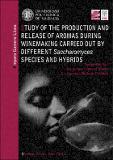Por favor, use este identificador para citar o enlazar a este item:
http://hdl.handle.net/10261/39639COMPARTIR / EXPORTAR:
 SHARE
BASE SHARE
BASE
|
|
| Visualizar otros formatos: MARC | Dublin Core | RDF | ORE | MODS | METS | DIDL | DATACITE | |

| Campo DC | Valor | Lengua/Idioma |
|---|---|---|
| dc.contributor.advisor | Querol, Amparo | - |
| dc.contributor.advisor | Belloch Trinidad, Carmela | - |
| dc.contributor.author | Gamero, Amparo | - |
| dc.date.accessioned | 2011-09-19T08:22:45Z | - |
| dc.date.available | 2011-09-19T08:22:45Z | - |
| dc.date.issued | 2011-09-19 | - |
| dc.identifier.uri | http://hdl.handle.net/10261/39639 | - |
| dc.description | 303 páginas.-- Tesis Doctoral de la Universidad Politécnica de Valencia (UPV) y del Instituto de Agroquímica y Tecnología de Alimentos (IATA-CSIC).-- Fecha de lectura: 29 de marzo de 2011 | es_ES |
| dc.description.abstract | [English:]Aroma is one of the most important attributes involved in wine quality. Current trend in winemaking consists of producing wines with different aroma nuances to offer variety of wines to a developing market. Several studies have demonstrated that low temperature fermentations favours aroma synthesis and retention. In this background, new wine yeasts able to perform fermentation at low temperatures improving wine aroma while maintaining good fermentation rates are necessary. This doctoral thesis explores the oenological traits of different Saccharomyces species and hybrids relevant for present-day wine industry, especially regarding aroma production, as well as the molecular bases underneath. This exploration has been possible using different biochemical, analytical chemistry and molecular techniques to perform enzymatic activity detection, aroma profile determination and transcriptome analysis in wine fermentations. Through this doctoral thesis the abilities of different Saccharomyces species and hybrids regarding primary aroma release and secondary aroma production, especially at low temperatures, has been elucidated in order to know the different possibilities that these yeasts offer to create new wines with different aromatic nuances. One of the general conclusions of this doctoral thesis is that production and release of aromas in winemaking depends on the strain carrying out the fermentation process. Nevertheless, sometimes there was a species tendency. On the other hand, the fact that fermentation temperature affects aroma synthesis but not always in the direction to aroma increase has been demonstrated. | es_ES |
| dc.description.abstract | [Español]:El aroma es uno de los más importantes atributos implicados en la calidad del vino. La actual tendencia en vinificación consiste en producir vinos con diferentes matices aromáticos para ofrecer variedad de vinos a un mercado en desarrollo. Varios estudios han demostrado que las fermentaciones a baja temperatura favorecen la síntesis y la retención de los aromas. En este contexto, son necesarias nuevas levaduras vínicas capaces de llevar a cabo fermentaciones a bajas temperaturas y que mejoren el aroma del vino, manteniendo buenas tasas fermentativas. Esta tesis doctoral explora las características enológicas de diferentes especies e híbridos del género Saccharomyces relevantes para la industria vínica actual, especialmente en lo referente a la producción del aroma, así como las bases moleculares subyacentes. Esta exploración ha sido posible usando diferentes técnicas bioquímicas, de química analítica y moleculares para llevar a cabo detección de actividad enzimática, determinación del perfil aromático y análisis transcriptómico en fermentaciones vínicas. A través de esta tesis doctoral, las habilidades de las diferentes especies e híbridos del género Saccharomyces en lo que se refiere a la liberación del aroma primario y a la producción del aroma secundario, especialmente a bajas temperaturas, han sido dilucidadas para conocer las diferentes posibilidades que estas levaduras ofrecen para crear nuevos vinos con diferentes matices aromáticos. Una de las conclusiones generales de esta tesis doctoral es que la producción y liberación de aromas en vinificación depende de la cepa que lleva a cabo el proceso fermentativo. Sin embargo, en ocasiones hay una tendencia de especie. Por otra parte, se ha demostrado el hecho de que la temperatura de fermentación afecta a la síntesis de aromas pero no siempre en la dirección del aumento. | es_ES |
| dc.language.iso | eng | es_ES |
| dc.rights | openAccess | es_ES |
| dc.subject | Wine | - |
| dc.subject | Aroma | - |
| dc.subject | Yeast | - |
| dc.subject | Saccharomyces | - |
| dc.subject | Hybrids | - |
| dc.title | Study of the production and release of aromas during winemaking carried out by different Saccharomyces species and hybrids | es_ES |
| dc.type | tesis doctoral | es_ES |
| dc.description.peerreviewed | Peer reviewed | es_ES |
| dc.type.coar | http://purl.org/coar/resource_type/c_db06 | es_ES |
| item.openairetype | tesis doctoral | - |
| item.grantfulltext | open | - |
| item.cerifentitytype | Publications | - |
| item.openairecristype | http://purl.org/coar/resource_type/c_18cf | - |
| item.fulltext | With Fulltext | - |
| item.languageiso639-1 | en | - |
| Aparece en las colecciones: | (IATA) Tesis | |
Ficheros en este ítem:
| Fichero | Descripción | Tamaño | Formato | |
|---|---|---|---|---|
| Doctoral Thesis A Gamero.pdf | 11,99 MB | Adobe PDF |  Visualizar/Abrir |
CORE Recommender
Page view(s)
400
checked on 19-abr-2024
Download(s)
1.054
checked on 19-abr-2024
Google ScholarTM
Check
NOTA: Los ítems de Digital.CSIC están protegidos por copyright, con todos los derechos reservados, a menos que se indique lo contrario.
